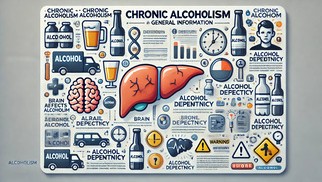Chronic Alcoholism: Understanding the Condition, Consequences, and Treatment


Chronic alcoholism is a persistent and destructive dependence on alcohol, classified under Alcohol Use Disorders (AUDs). It has significant physical, psychological, and social ramifications, affecting millions globally.This comprehensive article explores what defines chronic alcoholism, the amount of alcohol linked to this condition, the diseases it can cause, and treatments, including detailed information on the medication Antabuse.
What Is Considered Chronic Alcoholism?
Chronic alcoholism involves long-term, harmful alcohol consumption that leads to dependency and adverse consequences. It is characterized by the following symptoms:
- Craving: A powerful urge to drink alcohol.
- Tolerance: Requiring more alcohol to achieve the same effect.
- Withdrawal Symptoms: Physical and psychological discomfort upon cessation.
- Impaired Control: An inability to stop drinking despite adverse consequences.
Diagnosis typically follows DSM-5 guidelines, assessing compulsive drinking behaviors and their impact on daily life.
How Much Alcohol Leads to Chronic Alcoholism?
While there is no universal threshold, exceeding the following guidelines can increase the risk of dependency:
- Men: More than 14 standard drinks weekly or more than 4 drinks on any given day.
- Women: More than 7 standard drinks weekly or more than 3 drinks daily.
A standard drink is equivalent to 12 ounces of beer, 5 ounces of wine, or 1.5 ounces of distilled spirits. Chronic alcoholism can also develop in individuals who drink less but are genetically predisposed or psychologically vulnerable.
Chronic Diseases Caused by Alcoholism
Alcoholism is linked to a wide range of chronic diseases, including:
Liver Diseases:
- Alcoholic Hepatitis: Liver inflammation leading to pain and jaundice.
- Cirrhosis: Irreversible scarring that impairs liver function.
Cardiovascular Conditions:
- Hypertension and cardiomyopathy, which weaken the heart.
- Irregular heart rhythms, increasing stroke risk.
Neurological Damage:
- Wernicke-Korsakoff Syndrome, caused by Vitamin B1 deficiency, leading to memory loss.
- Cognitive decline and dementia.
Pancreatitis:
- Chronic inflammation that disrupts digestion.
Increased Cancer Risks:
- Alcohol raises the likelihood of cancers in the liver, throat, breast, and colon.
Weakened Immune System:
- Alcohol compromises immune defenses, prolonging illness recovery.
What Are the "4 Wives of Alcoholics"?
This metaphor describes the inevitable burdens that "accompany" alcoholics throughout their journey:
- Ill Health: Alcohol leads to life-long health complications such as liver and heart disease.
- Financial Ruin: The cost of addiction, healthcare, and legal troubles often results in financial distress.
- Broken Relationships: Alcoholism deteriorates trust in families, often causing isolation.
- Mental Turmoil: Anxiety, depression, guilt, and shame frequently plague chronic alcoholics.
Treating Chronic Alcoholism
Effective treatment often involves a comprehensive approach addressing physical, psychological, and social aspects. Key components include:
- Detoxification: Supervised detox is the first step in managing withdrawal symptoms safely.
- Therapy and Support: Psychological interventions such as Cognitive Behavioral Therapy (CBT) or support groups like AlcoholicsAnonymous (AA) help address emotional dependencies.
- Medication: Pharmacological therapies play a crucial role in recovery. One such option is Disulfiram, commonly known as Antabuse, detailed below.
Antabuse: A Medication for Treating Chronic Alcoholism
How It Works
Antabuse works by inhibiting the liver enzyme aldehyde dehydrogenase (ALDH), which breaks down acetaldehyde, a toxic by-product of alcohol metabolism. When alcohol is consumed, acetaldehyde builds up in the bloodstream, causing:
- Nausea and vomiting.
- Flushing of the face and neck.
- Rapid heartbeat and dizziness.
- Anxiety and severe headaches.
These adverse reactions make consuming alcohol an unpleasant experience, discouraging drinking.
Administration and Usage
Antabuse is taken orally, once daily, under medical supervision. It should only be started after 12 to 24 hours of alcohol abstinence. Regular monitoring is vital to ensure liver health, as Antabuse can sometimes cause liver toxicity.
Patients taking Antabuse must avoid all alcohol sources, including hidden ones in mouthwashes, over-the-counter medications, or certain foods.
Effectiveness of Antabuse
While Antabuse does not address cravings, it serves as a deterrent by fostering fear of unpleasant reactions. It is most effective in motivated individuals with strong social or medical support systems. When combined with therapies, it helps reinforce a commitment to sobriety.
Therapy and Support
Therapy and support are essential components of recovery from chronic alcoholism, addressing the psychological and emotional drivers of addiction. Cognitive Behavioral Therapy (CBT) helps patients identify triggers, develop healthier coping mechanisms, and replace destructive habits with constructive ones. Similarly, Motivational Enhancement Therapy (MET) encourages individuals to set and achieve sobriety goals by fostering self-motivation. Family therapy is another crucial aspect, helping to heal strained relationships and teaching family members how to provide effective support while addressing any enabling behaviors.
Peer support groups, such as Alcoholics Anonymous (AA), play a pivotal role by creating a sense of community and accountability among individuals in recovery. Participants share their experiences and gain encouragement from others at different stages of the recovery process. Alongside traditional therapy, behavioral interventions like contingency management use reward-based systems to reinforce positive actions, such as maintaining sobriety. Holistic support through mindfulness practices, exercise, and proper nutrition further aids recovery by enhancing overall physical and emotional well-being. These therapeutic approaches, combined with medical treatments like Antabuse, establish a comprehensive framework to guide individuals toward long-term sobriety and a healthier, more fulfilling life.
Conclusion
Chronic alcoholism is a life-altering condition, but it is not insurmountable. By understanding its causes, consequences, and treatment options, individuals can make informed choices about their health. Medications like Antabuse, when paired with therapy and lifestyle changes, offer a powerful pathway to recovery. If you or someone you know struggles with alcoholism, seek professional help today. Early intervention can change the course of life for the better. This article is for informational purposes only and does not substitute professional medical advice. Always consult a qualified healthcare provider for diagnosis and treatment.
Article post: Editorial Team of RXShop.md
(Updated at Jan 6 / 2025)

